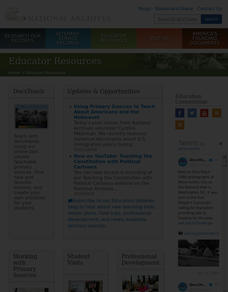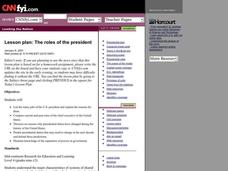Curated OER
We the People…in the News
Students use the newspaper to explore the world around us, our past and our government. In this civics unit, students complete 40 different lessons in civic education using that day's newspaper to reinforce the concept being taught.
Curated OER
Memorandum Regarding the Enlistment of Navajo Indians
Young scholars examine the Navajo dictionary used by the U.S. military in W.W. II. They role-play Navajo messengers and Marine Corp staff. They research the Battle of Iwo Jima and confirm or discount the claim that Navajos made the...
Curated OER
Voting
High schoolers investigate voter participation in the U.S. They watch and discuss a Bill Moyers video, complete a handout, and develop a plan to help a community overcome obstacles to voter participation.
Curated OER
Post Civil War Reconstruction
Students analyze the process of Reconstruction after the Civil War. In this U.S. History lesson, students discuss specific details about Reconstruction with the class, then complete a worksheet with multiple activities reinforcing the...
Curated OER
Article 9 of the Japanese Constitution
Students examine the historical background of Article 9 of the Japanese Constitution, analyze the role of defense in our world today, and evaluate the repercussions of Article 9.
Curated OER
Government
Eighth graders analyze the purposes of government. They examine or assess the importance of citizenship to the individual or to society at large (e.g., the importance of voting). Students explain the structure and functions of the three...
Curated OER
Comparative Government: Japan & the United States
Learners compare the governmental systems of Japan and the United States. As a class, they discuss the differences between the parliamentary system and the presidential system. Pupils read provided handouts about the duties of a a...
Curated OER
First Amendment: Crossword Puzzle
In this United States history worksheet, students use the 14 clues in order to fill in the crossword puzzle with the appropriate answers pertaining to the First Amendment.
Curated OER
Democratic Process, Constitutional Issues, Local Government
Twelfth graders engage in the decision making process so as to encourage them to become active citizens upon graduation from high school.
Minnesota Center for Community Legal Education
Minnesota v. Hershberger
Freedom of religion has been a controversial, yet fundamental, tenet of the United States since even before the nation's birth. In a well-constructed lesson, the class compares the Minnesota Constitution to the US Constitution as a means...
James Madison Memorial Fellowship Foundation
A Picture is Worth a Thousand Words
This exercise on the Constitution requires small groups to design a visual metaphor that expresses the concept behind one of seven principles: popular sovereignty, federalism, republicanism, separation of powers, checks and balances,...
Curated OER
Living News: Classroom Materials
Young scholars explore controversial current events. In this Bill of Rights lesson, students research selected issues and examine the issues from different perspectives. Young scholars script and record news stories that feature their...
Curated OER
A House Dividing: The Growing Crisis of Sectionalism in Antebellum America
Students explore the debates over American slavery and the power of the American federal government for the first half of the 19th century and how the regional economies and political events produced a widening split between the states.
National Endowment for the Humanities
Lesson 2: The Debate in Congress on the Sedition Act
Pupils research and discuss the provisions in the Constitution that supported the arguments for and against the Sedition Act. They articulate objections to and arguments in favor of the Sedition Act.
Curated OER
Constitution Word Search Puzzle
In this social studies learning exercise, students find the words that are related to the concept that is the theme of the word search puzzle.
Curated OER
Raids and Arrests of Enemy Aliens
Student read background summary information and debate how much control did the government require to keep the nation safe. They research how World War II restrictions on enemy lines were enforced and how it related to the U.S....
Curated OER
Telegram from Senator Joseph McCarthy to President Harry S. Truman
Students research Senator Joseph McCarthy's February 9, 1950 speech, given at Wheeling, West Virginia, in which he claimed more than 200 State Department employees were members of the Communist Party.
Curated OER
Civil Liberties and National Security
Students identify the civil liberties outlined in the U.S. Bill of Rights and discuss the importance of these liberties in today's society. They research examples of when Congress has taken legislative action to protect national security.
Curated OER
Defining Citizenship in Recent Events
Students research the rights and responsibilities of citizens and non-citizens living in the U.S. They present a dialogue that showcases their research and take a quiz on the material.
Curated OER
The Roles of the President
High schoolers list the many jobs of the U.S. president and explain the reasons for them. They compare current and past roles of the chief executive of the United States.
Curated OER
Uniform Blues
Fourth graders explore what the U.S. Constitution is and why it is important, the purpose of the state constitution, and its relationship to the U.S. Constitution and the similarities and differences among federal, state and local...
Curated OER
Due Process
Students understand the legal term "due process of law" and its historical origins. They discuss the requirements for "due process of law" in both the U. S. Constitution and the Indiana Constitution and how those rights are similar or...
Curated OER
War Making: Executive and Legislative Powers
Students examine executive and legislative powers. In this federal powers lesson, students determine who has the power to wage war in the U.S. government. Students analyze the Constitution and research historical precedents regarding...
Curated OER
POWERS OF THE PRESIDENT: THE CASE OF LATVIA
Students compare the powers of a U.S. president to those of leaders of other countries. They pretend they are presidential advisors and make decisions as a group as to what the president has the right do in different situations.

























